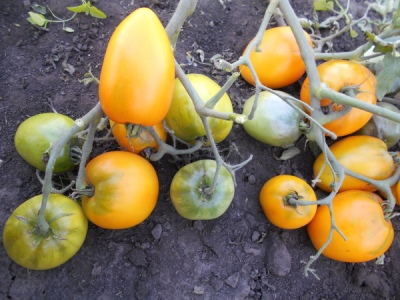
- Authors: Gubko Valentina Nikolaevna, Kamanin Andrey Aleksandrovich, Agrotechnological firm 'Agros' LLC
- Appeared when crossing: by natural mutation of the Fighter variety
- Year of approval: 2007
- Category: grade
- Growth type: determinant
- Appointment: for whole fruit canning
- Ripening period: mid-season
- Ripening time, days: 110-115
- Growing conditions: for open ground
- Marketable fruit yield,%: 69-86
Buyan yellow tomato stands out among other tomato crops for its somewhat unusual origin. Nevertheless, this variety deserves the closest attention of gardeners. Having deeply studied its features, it will be possible to achieve a good result.
Breeding history
Buyan yellow appeared as a result of a natural mutation of the Fighter variety. However, in order to bring it to the required varietal conditions, the efforts of breeders were nevertheless required. Work on it was carried out in the agro-technical firm "Agros". The main part of the project was supervised by breeders Gubko and Kamanin. The official admission to the use of Buyan yellow in vegetable gardens was approved in 2007.
Description of the variety
This plant belongs to the proven determinant group. The bushes of such tomatoes reach a height of 50-60 cm. They are quite compact and can grow almost everywhere. As usual, tomatoes have a medium-sized leaf, painted in dark green tones. It should also be emphasized that Yellow Buyan is a standard tomato.
The main qualities of the fruit
When the tomato is not ripe, it is green in color. A tiny dark speck is observed near the peduncle. In the process of ripening, the berries turn yellow. Their mass can be 60-120 g. In shape, each berry is close to a cylinder; fruits develop on intermediate inflorescences and are distinguished by good keeping quality.
Taste characteristics
The dominant role is played by sweet taste. But a characteristic sourness is always mixed with it. The proportion of sugar is from 2.1 to 3.3% of the mass of the tomato.
Ripening and fruiting
Buyan yellow is classified as a mid-season tomato. Between the release of green shoots and harvesting, on average, 110 to 115 days pass.
Yield
Plantation harvesting shows a very ambiguous picture. Its value can vary from 163 to 494 centners per hectare. Therefore, the conclusion is simple - Buyan yellow strongly depends on the quality of agricultural technology. The yield of marketable fruits ranges from 69 to 86%. Private gardeners will also have to take care of their plantings much more than undemanding varieties.
The timing of planting seedlings and planting in the ground
Sowing seeds in containers should take place 50-55 days before the intended transplantation into open ground or greenhouse. It is necessary to be guided by both weather conditions and the condition of the seedlings themselves, their readiness or unavailability. Most often, sowing is carried out in March. The boxes are kept under the film until the tomatoes themselves germinate.

Growing tomato seedlings is an extremely important process, because it largely depends on whether the gardener can harvest at all. All aspects must be taken into account, from seedbed preparation to planting in the ground.
Landing scheme
Normally for 1 sq. m there may be 4 or 5 bushes. This circumstance is associated with their relatively low growth and compactness. There are even statements that you can have 1 sq. m up to 6 plants. But testing them in practice is hardly worth it. Recommended placement on the site according to the rule of 700x300 or 700x400 mm.

Growing and care
Buying yellow is not required for Buyan. It is also not worth tying it up. The plant is relatively resistant to tobacco mosaic virus. Timely watering is imperative. Complex mineral mixtures are used for feeding. Protection against diseases and harmful insects that actively eat plantings is also very relevant.
Cracking may indicate:
extremely wet ground;
too active use of fertilizers;
too much loading of the bush with fruits;
low light.
The last point - insufficient light - can be bypassed by choosing the right site. It is necessary to check that the ground is not only illuminated, but also well warmed up. It is allowed to plant Buyan yellow in the immediate vicinity of other garden plants. Watering is usually done every 6-7 days. It is necessary to make it more frequent or more rare only when absolutely necessary.
Additional protection against late blight will not be superfluous. It is possible to provide it by spraying with copper sulfate (in the form of a solution with a concentration of 1%). This should be done 3-4 times during the growing season. Mulching is carried out using:
hay;
sawdust;
straw.




A plant needs different micronutrients at each stage of growth. All fertilizers can be divided into two groups: mineral and organic. Folk remedies are often used: iodine, yeast, bird droppings, eggshells.
It is important to observe the rate and period of feeding. This also applies to folk remedies and organic fertilizers.


Growing regions
The culture is officially regionalized in Western Siberia.This suggests that in areas with more favorable climates, success is guaranteed. However, precise information on this matter has not yet been collected.

























































































